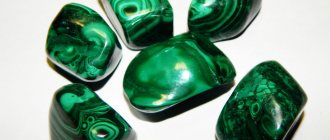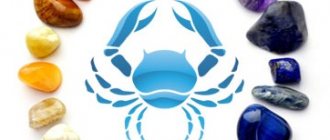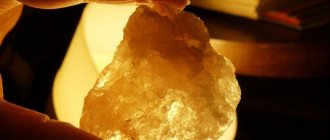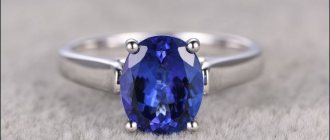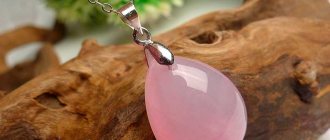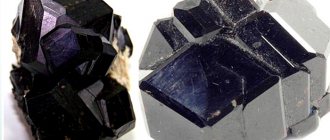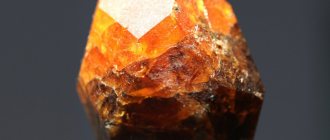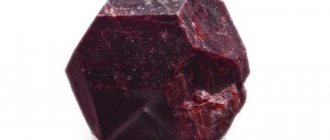Garnet is a gem known since ancient times. Many ancient peoples found placers of certain types of mineral. Thanks to this, there are many legends about its magical properties. It is often worn by modern women who want to show off their sophistication.
History and origin of pomegranate
In Europe and the Middle East, red garnet (later Pyrope and Altandine) was mined. Due to its garnet color and shape, which is similar to the fruits of the pomegranate tree, the modern name of the stone is derived from its fruit, pomegranates. This name was coined in 1270 by the alchemist Albertus Magnus.
The 17th century marked the discovery of garnet as jewelry.
For a long time, the stone was considered a healing medicine that stopped bleeding. It could not be distinguished from spinel, hyacinth and other crystals. But garnet could always be distinguished from a harder and more deeply colored ruby.
It was then fashionable to wear Czech jewelry, and the large deposit found in this country contributed to the popularity of garnet throughout the world.
Today, the popularity of the stone does not decrease. Products made from this gem are sold in any jewelry store. But the most beautiful specimens are in private collections.
Pomegranate varieties with light grains
Many people have heard about the existence of pomegranates with light or white grains. Accustomed to the rich purple or cherry hue of the fruit seeds sold in stores and markets, buyers are distrustful of other types of pomegranate, considering them unripe. But in fact, this is not science fiction and not GMOs, but simply a type of culture. The grains are not white, but rather white-pink, transparent.
Features of stone mining
Garnets are mined from various geological deposits. Pyrope garnet is found in diamond-bearing pipes (in Yakutia and South Africa). Altandin is mined in the world's shale and gneiss deposits. Garnets similar to grossular are found in limestone.
The largest deposits of garnets are found in these countries:
- Canada;
- Mexico;
- Brazil;
- USA;
- Finland;
- Sri Lanka;
- Madagascar
- Czech Republic;
- Ukraine;
- Azerbaijan.
In Russia, in addition to the Yakutsk deposit, there are garnet developments in Karelia and on the Kola Peninsula (Altandines), and the Ural deposit of uvarovite is also known.
Productivity
The first inconspicuous fruits from pomegranate can be expected when the tree reaches three years of age. Full yield is maintained on average for up to 40 years .
Fruit formation and subsequent ripening at an optimal temperature of 25 degrees takes from 4 to 5 months from spring to late summer.
The fruits are collected in early autumn. Productivity varies from 20 to 60 kilograms per plant .
How to store the harvest?
Once harvested, pomegranate fruits can be stored for up to several months. To do this, it is enough to meet a number of simple conditions:
- the fruits must be whole - without cracks;
- room temperature – 1-2 degrees;
- air humidity – from 80 to 85%.
Good ventilation is also a must.
Colors and types of stone
There is a wide variety of colors and modifications of garnet. Let's take a closer look at them.
- Pyrope. The most common in nature. It has a rich red color, approaching purple.
- Altandin. Lighter than pyrope, there are purple and black varieties.
- Rhodolite. Some consider it a hybrid of althandine and pyrope, but there are experts who classify it as a separate group. This variety is colored in all shades of pink.
- Spessartine. The stone is colored brown, orange, yellow, pink, red. This rare type of pomegranate is found in Germany.
- Hessonite. It is colored brown, honey and yellow, but purple tones can also be found.
- Grossular. The color is very similar to gooseberries (shades range from light green to swamp green). This is where its name comes from: gooseberry is translated from Latin as “grossular”.
- Uvarovite. Quite a rare species that is found in the Urals. It has a bright emerald color.
- Andradite. This pomegranate is common in Brazil. They are colored red, yellow, green.
- Melanitis. A very rare, opaque stone. Painted matte black.
- Leucogranate. The second name is white garnet. Its color is transparent. This stone is not found in jewelry, but it is of great importance in industry.
With all the variety of types of minerals, we can certainly analyze whether a particular stone is a garnet only in laboratory conditions.
Popular varieties
Among gardeners, varieties with a short period of fruit ripening, frost resistance, early fruiting, and a rich harvest are popular.
Mangulati
Israeli variety of pomegranate. The fruits are formed of a flattened-round shape, the average weight is 180-220 g. The trees grow up to 5 m in height. The grains are red in color with a pleasant sweet and sour taste. The seeds are very oily, which is why pomegranate oil is made from them. Mangulati is used for processing into juice, fresh consumption, and in cosmetology for skin care.
Nana
The Nana variety comes from Asia Minor. The shrub does not exceed 1 m in height, the crown is medium dense, the leaves are small and oblong. Flowers and fruits are elongated. The pulp of the fruit is sweet and sour, the aroma is weak. Plants are sensitive to climatic conditions and love moist soil. The color of the garnet is carmine with a slight pink tint. You can grow it not only in the garden, but also in the room.
Guleisha
The fruit tree was bred through hybridization in Azerbaijan. The bushes grow spreading, the height does not exceed 3 m. The thorns are evenly distributed along all branches. The fruits are formed in different sizes, their weight varies from 200 to 600 g. The shelf life of the fruit is 240 days from the moment of removal from the tree. It is impossible to find the Guleisha variety on the Russian market; they are not imported to other countries.
Each variety has a different taste, appearance, and aroma, but they are united by a set of vitamins and microelements. Most varieties were bred in the laboratory, but based on wild trees. The plants were instilled with endurance, resistance to diseases and climatic conditions.
Artificial pomegranate
This variety of pomegranate from the laboratory is used only for industrial needs. Jewelers do not use synthetic garnet because the production method is expensive (the cost is equal to the cost of a natural stone). And manufacturers use garnet in construction, microelectronics, laser machines and other equipment.
Varieties of pomegranate with soft seeds
The varieties included in this group are often called seedless, but this is not true. The grains inside the fruit are soft and sweet, so it gives the impression of an unusual granular pulp. Bred by breeders to simplify the processes of juice production.
Known varieties:
- Mollar de Elche is a variety with pink pomegranates, with a thin, apple-like peel. Weight – 600-800 g, taste – sweet, pleasant. In Spain, this cultivar is cultivated on an industrial scale, supplying it to different countries of the world;
- Wonderful is a pomegranate bred in the USA, one of the first in the line of crops with soft grains. The bushes are low, the fruits are pinkish-cream, with a thin peel. The grains are juicy, large, with a pleasant sweet taste. There is no sourness or astringency. It is grown in industrial plantings in Israel and Peru.
Fruits with soft seeds give a good yield of juice and have a sweet taste. The agricultural technology of such varieties is standard and does not differ from the usual care of stone fruit pomegranates.
How to distinguish a fake from a natural stone
As mentioned above, the cost of producing synthetic stones is close to the price of natural stone. Therefore, to fake a stone, they often use painted glass, or pass off other minerals as garnet. It is difficult for a non-professional to determine the authenticity of a stone. Let's consider several ways.
- Natural stone is electrified like an ebonite stick, and if you rub it with fur, wool or hair, the mineral will begin to attract small objects.
- Synthetic materials and glass have a uniform color, while natural stones have a smooth color transition from one shade to another.
- The size of a natural pomegranate is no larger than the size of a coffee bean. Larger specimens are much less common in nature, and accordingly, they are very expensive.
- To distinguish natural stone from glass, just scratch it with a sharp object. Less hard glass will leave marks.
In a store, some methods are problematic to implement until the decoration is purchased. Therefore, you should refrain from visiting stores with a dubious reputation and suspiciously low prices. In a good store, where every customer is valued, there is no doubt about the authenticity of the product. If in doubt, you can contact an independent jewelry expert who will determine the authenticity of the jewelry for sure.
What are the types of pomegranate fruit?
All existing plant varieties are divided into two main categories. The first is characterized by tough, hard seeds inside the fruit. These species grow in the southern regions, where climatic conditions correspond to this crop. They are undemanding in terms of soil composition and care, so there are no difficulties in growing them.
Another category includes types of pomegranate with soft seeds, which are practically not felt when eating the grains. These species do not grow everywhere, as they are more capricious and require increased attention. Such varieties need to maintain the level of humidity and air temperature, and they also prefer a certain soil composition.
How many varieties of pomegranate are there?
More than five hundred cultivated varieties of pomegranate are known, and thanks to the efforts of breeders, their number increases every year. The goal is to breed species with increased resistance to diseases and low temperatures.
On the territory of the reserve in the village. Kara-Kala, which is located in Turkmenistan, has the largest collection of pomegranates. About 800 different types of crops grow here.
What varieties of pomegranate are there?
There are several types of pomegranate, from which all other hybrid forms were derived. Each of them differs not only in the size and color of the fruit, but also in the color of the grains, as well as other characteristics. Therefore, to understand the difference between them, it is necessary to consider some varieties separately.
Ordinary
This species is a deciduous tree, the height of which can reach 10 m. The plant has a highly branched trunk, angular shoots and a wide crown. The leaves of the common pomegranate are oval, leathery, and light green in color. They are located opposite on the shoots and are attached using short petioles. The length of the plates is about 6 cm.
The flowers are bell-shaped, red-orange in color, and can be single or double. Their diameter does not exceed 5 cm. The fruits of the ordinary pomegranate are spherical in shape and red or red-brown in color. Their size is 10-12 cm. The grains are juicy, large, and coarse.
Important! An ordinary pomegranate seedling begins to bear fruit at 3-4 years.
The flowering period is from spring to autumn, the fruits ripen in August-October. The growing season is 180-210 days. The lifespan of this variety is 50-60 years.
The ordinary pomegranate has a high yield; up to 60 kg of fruit can be obtained from one adult plant.
Yellow
This fruit can grow as a shrub or tree. Its height does not exceed 5 m. The skeletal branches of the plant are covered with small thorns. Thin shoots with light brown bark are attached to them.
The leaves of the yellow pomegranate variety are oblong-rounded, reaching a length of 8 cm and a width of 2-3 cm. They are located opposite on the shoots. The plates have a glossy surface. The leaves are attached with short petioles and collected in bunches.
Yellow pomegranate flowers have a red-orange hue. They are enclosed in inflorescences of 2-5 pieces. The fruits of the variety are large, their diameter can reach 17 cm. A distinctive feature is the color of the peel - yellow-olive. The grains are juicy, fleshy, sweet, pale pink in color.
Yellow pomegranate fruits are often mistaken for unripe due to the unusual color of the peel.
Soqotran
This variety is considered the predecessor of the common pomegranate. It is found naturally on the island of Socotra. Prefers limestone and rocky soils.
Socotrans pomegranate is an evergreen plant, no more than 4.5 m high. The leaves are oval, leathery with short petioles. The flowers are bell-shaped, pink in color, slightly raised on the peduncle.
The fruits are characterized by a dense peel, the shade of which can vary from scarlet to yellowish-orange. Their diameter does not exceed 10 cm. The grains have a sweet and sour taste.
Socotran pomegranate is not cultivated
Medicinal properties
The features of garnet in lithotherapy (the teaching of alternative medicine about the influence of stones on the human body) are most often considered in red stones. According to the rules of sympathetic magic, the red stone is similar to blood, so it is able to heal the human circulatory system.
The teaching talks about the healing properties of pomegranate:
- stops bleeding, promotes wound healing;
- fights inflammation, promotes tissue regeneration;
- equalizes blood pressure;
- has a beneficial effect on the heart and blood vessels;
- relieves headaches, migraines;
- reduces the painful course of allergies;
- weakens the course and consequences of skin diseases;
- helps with gastrointestinal diseases;
- gives vigor and vitality to fight illness and stress.
The most powerful types of pomegranate are Pyrope and Altadin. Other colors are also found in lithotherapy. For example, a yellow garnet will help with skin problems, a green gem heals the nervous system.
To achieve an interesting effect from garnet, it is very important to combine it correctly with metals and other stones.
Garnet combined with gold can prevent lung diseases. Placing a ring on the ring finger of the left hand improves memory. A stone in a silver frame can enhance the owner’s immunity.
Pomegranate beads help cure lung diseases and headaches. Pendants help with gastrointestinal diseases. The bracelet is recommended for allergy sufferers.
Where can it be cultivated?
The common pomegranate is not considered demanding in terms of soil and its moisture - it can grow even in saline soil with air drought. However, to obtain a good harvest in such cases, artificial irrigation must be provided. Pomegranate is considered a plant of tropical and subtropical climates, therefore it is cultivated primarily in countries where similar conditions are observed:
- the average temperature in summer is more than 20 degrees;
- in winter the temperature does not drop below zero;
- The climate is mild.
The homeland of the common pomegranate is considered to be the Caucasus, Asia (Minor and Middle), as well as Iran. However, this plant became widespread throughout the Mediterranean regions in ancient times.
A small number of wild specimens are also found in southern Europe and northern Africa.
In Russia, the fruit lives mainly in Sochi and Southern Dagestan .
Magic properties
Due to its properties of multiplying the power of the owner, for witches, magicians and other owners of magical abilities, the gem is a powerful amulet. Even for the crusader knights who fought in foreign lands, rings with garnets helped them overcome the hardships of life on the march. The main condition for a person possessing such a strong amulet is determination and fight for a good cause. If a person’s soul is full of evil, then a garnet can entangle him in a tangle of his own intrigues. It happens that such people find themselves on the verge of a mental disorder, which echoes bankruptcy and ruin in life.
Let's consider the main magical properties of garnet stone.
- Capable of enhancing the owner’s energy. A person becomes more alert, less tired;
- Develops intuition to search for hidden enemies, helps to avoid trouble;
- Protects against dangers associated with the water element;
- Helps ignite passion. Helps to win the heart of an unapproachable lady, and makes girls more desirable and mysterious to men.
- Helps to reveal hidden talents, adding individuality to the most modest person;
- For creative people it is a source of creative strength, brings inspiration and contributes to the implementation of creative plans.
It should be understood that the stone awakens predatory tendencies in a person. Naturally aggressive people can become overly aggressive.
To prevent a pomegranate amulet from losing its power, you should periodically leave it overnight in a container with salt. “White gold” is capable of returning the mineral to its former strength, drawing out negative energy.
Subspecies
The common pomegranate has many subspecies, among which are:
- Kizil Anor . Early ripening with pink-scarlet skin and sweet and sour taste.
- Ak Don Crimean . Large oval fruits with thin skin.
- Gyuleisha pink . Creamy white crust, dark cherry grains with a sweet and sour taste.
- Bala-mursal . Slightly flattened fruits with red or crimson grains. It is considered one of the best varieties in taste.
Also worth noting is Achik-Anor. The skin is thick and dark green. The grains are dark cherry color with a bright sweet and sour taste.
Who is the garnet stone suitable for?
Astrologers believe that the red variety of garnet corresponds to the fire element. Despite this, it can be useful for many zodiac signs. It is important to know that if a stone is exposed to a person’s aura for a long time, it can cause harm.
Which zodiac signs are suitable for red types of pomegranate?
- This gem will not calm Scorpio’s temperament, but it will help direct the energy in the right direction.
- It will help Aquarius to concentrate on one thing and help him find the most important thing in the owner’s life.
- It will make Sagittarius more sensitive to others and protect them from rash actions.
- It will bring good luck to Gemini in creativity, and will guide them towards making difficult decisions in a stable manner.
- It will add more strength to Libra, give confidence and determination.
- It will help Virgos find harmony in relationships and help reveal their feelings to their chosen one.
- The best amulet union is with Capricorn. Thanks to him, Capricorn makes profitable connections, which contributes to career growth.
The gem is suitable for these signs. But there are signs for which the garnet amulet is useless, and for some signs it can be harmful. For example, Leos, natural leaders, can become aggressive and hot-tempered under the influence of the stone.
Representatives of water signs, Cancers and Pisces, will be constantly moved by the talisman, forced to explore something new, which is fraught with discomfort and can lead to depression.
Grossular is the only stone from the garnet family that can suit absolutely everyone. He is quite peaceful, and weaker than his red counterparts.
History of selection
The origin of pomegranate dates back to distant prehistoric centuries - according to rough estimates, the plant is about 4 thousand years old. Modern forms of the tree come mainly from Northern Iran and Eastern Transcaucasia .
The pomegranate was mentioned several times in both European and Central Asian histories.
In the 20th century, active plant selection began . On the territory of the USSR, successful attempts were made to develop a variety of pomegranate that does not suffer so much from freezing temperatures. Thanks to selection, the fruit has become available to ordinary citizens living in the northern regions.
Features of product use
Jewelers insert the precious mineral into rings, earrings, and pendants. The preferred cut is cabochon or diamond. If the stone is beautiful, its processing is minimal. Also, the elements of garnet beads are only polished.
Historically, stones, including garnets, were set into luxury items, ranging from vessels and caskets to royal regalia and Gospel frames.
In addition to jewelry, garnets are used in electronics, grinding, and construction. In this case, synthetic stones or the smallest samples of natural stones are used.
New time - new forms
At the turn of the 19th and 20th centuries, metal spheres were replaced by other designs. During the Russian-Japanese War of 1904-1905, a fragmentation grenade appeared, which for many years became an example of a design for similar types of ammunition - the N.S. Lishin hand grenade, first used in the battle of Mukden.
For the casing, the Russian army used shell casings filled with pyroxylin, and a Nobel capsule fuse as a detonator. The Japanese used tin boxes with melinite, equipped with a kickford cord and a long wooden handle, which acted as a stabilizer when throwing.
New grenades appeared during the First World War.
A grating fuse was actively used (in a tube covered with a flammable composition there was a ribbed rod on a cord with a ring). When the ring was pulled out, a spark from friction ignited the retarder. The most famous are German and French examples of grenades.
The first hand grenade in the British Army, the Mills fragmentation grenade, became the most used on the fields of the First World War. This ammunition was supplied to Kolchak's White Army during the Civil War. The grenade had an oval-shaped body made of cast iron with vertical and horizontal notches.
The charge was amatol. Weight when equipped - 600 grams (explosive 60-70 grams). For detonation, a shock-safety mechanism was used, consisting of a pin, a bracket and a firing pin with a mainspring. Before use, the fuse was screwed into the bottom.
The time before the explosion is 7 seconds, the scattering of fragments is from 30 to 100 meters. It is worth noting the F1 grenade, which became the prototype of the famous “lemon”.
Product care
To ensure that the stone always looks attractive, you should purchase jewelry with garnet only on a sunny day.
If you received the product from a previous owner, you should clean the stone by placing it in running water for a day.
Once the mineral is in your hands, there are easy rules for caring for the stones so that they do not become dirty.
- If it becomes dirty, wash the jewelry in a mild soap or saline solution.
- A soft brush will help for cleaning. Can be used with a couple of drops of ammonia.
- For shine, wipe the stone with a soft cloth, avoiding hard sponges and abrasives.
- For storage, you should remove the pomegranate away from sharp objects and chemical materials. Store separately from other jewelry, in a separate velvet bag.
We took a closer look at the precious mineral, which is called the exotic fruit, pomegranate. We learned its main properties and features. We learned that a pomegranate, chosen correctly, will become a talisman for many years. It will lead the owner to wealth and happiness when used correctly.
Excursion to the botanical garden
To get acquainted with all the variety of varieties, you need to visit the Nikitsky Botanical Garden , located on the Crimean peninsula.
The collection, unique in its composition, includes
about 340 varieties of pomegranate .
Here you can find breeding plants, on the creation of which scientists of the former Soviet Union worked for many years. Next to them grow exotic varieties of pomegranate, brought from different parts of the world.
Tart and sweet from Iran (Halva, Sharodi). Small-fruited, dwarf from Japan (Punicagranatumvar). Sweet and sour from Central Asia (Kyzym, Ulfa, Achik-Dona). With soft seeds, or even seedless from America (Wanderful).
Of course, along with them, domestic varieties . For high quality, early and medium fruit ripening, high yield.
Selected varieties Nikitsky ranniy, Krymsky striped, Sochny 110 and others have firmly settled in the household plots of not only Russian but also foreign farmers.
Photo of Garnet stone
Landing rules
When planting a pomegranate seedling, you need to consider a number of rules:
- It is best to do this in late spring;
- dimensions of the landing pit - 60 by 70 centimeters;
- Approximately 15 centimeters of fertile soil should be poured onto the bottom;
- When planting, be sure to straighten the roots and carefully cover them with soil.
After this, it is necessary to water the soil and mulch to retain moisture. Dry weed, straw or humus will do .
Real use in combat
In open areas, the high-explosive effect (overpressure damage) of F-1 is noticeable at a distance of 3 - 5 meters from the explosion site. The radius of action of fragments (confident destruction) reaches 50, sometimes 70 meters.
The largest fragments can fly 200 meters from the epicenter of the explosion.
These features also dictate the methods of using a grenade in battle:
- it is most effective in confined spaces, that is, in rooms where the destructive power of fragments is maximum;
- indoors and the high-explosive effect is enhanced several times, which leads to concussions and also completely disorients;
- F-1 is very useful when organizing sabotage as the main element of tripwires, as well as for blowing up vehicles, warehouses, etc.
Sometimes tripwires are placed using two or more grenades.
And if you remove the moderator, you can achieve one important advantage, i.e., an instant explosion.
The same effect will be given by grenades equipped with a mine fuse, which acts instantly.
Specifications
The performance characteristics (performance characteristics) of the F-1 are summarized in a table and present the following picture:
| Weight | 600g |
| Weight of explosive filling | 60g |
| How far can you throw | 50-60m |
| Dispersion radius of lethal grenade fragments | 40-50m |
| At what distance is it safe to be in the event of an explosion? | 200m |
| Moderator burning time | 3-4sec |
| Number of fragments after explosion | up to 300 |
| Length | 110cm |
The characteristics of the F1 grenade indicate that this explosive device is almost ideal for defensive operations. And also for using it in sabotage activities.
The radius of destruction allows you to inflict significant damage to enemy personnel.
The grenade is very effective when used in tripwires, as a defensive measure if it is not possible to install anti-personnel mines.
Anti-tank hand grenade RPG-43 model 1943
It appeared on the fronts in mid-1943. It was intended exclusively for combating armored targets - it destroys armor up to 75 mm, thanks to its cumulative high-explosive action. Explodes instantly upon contact with an obstacle. Throwing is carried out only from a trench, in order to avoid hitting the thrower. You need to throw a grenade so that it hits the armor with its bottom. This is facilitated by its balancing and flight stabilizer, consisting of two fabric tapes and a cap, which act as a parachute during the flight of the grenade. The weight of the grenade is 1200 g.
Externally, the grenade looks like this: a cylindrical body turning into a cone. Below its truncated part is a wooden handle; in its upper part there is a cotter pin that holds the lever. Trying to unscrew the handle to remove the fuse is unacceptable.
The RPG-43 is extremely dangerous. Particular attention to specimens with a rotten handle and a fallen off stabilizer cap.
Advantages and disadvantages
The F-1 grenade has been in service with many armies for decades. In the near future, and even in the distant future, it is unlikely to be discontinued.
The reason for this is its undeniable advantages.
- Ease of manufacture and low cost of the material from which the body is made.
- A simple and reliable fuse that operates remotely and reliably.
- High lethality, especially in confined spaces.
The disadvantages of this projectile include the very small fragments formed during the explosion. They have low lethality.
The disadvantage of its fuse is that the moderator gives the enemy a chance of salvation, albeit a small one. The F-1 is a rather heavy projectile; not everyone can throw more than half a kilogram of cargo far and accurately.
Offensive grenades RGD are a kind of analogue of the F-1. But they are twice as light as it, but they also contain twice as much explosive. The RGD grenade has the same type of fuse as the F-1.
Due to the smaller number of fragments, but a greater high-explosive effect, it is used in offensive operations.
Another type is the Rgn offensive grenade. Their advantage over F1 is also their lighter weight.
In addition, the range of action of both the RGD and RGN is of considerable importance - 15 - 20 meters.
What does a car's front-wheel drive look like and what parts does it consist of?
The top photo shows a car's front-wheel drive assembly. At the ends of the drive there are grenades (constant velocity joints - CV joints). On the left is an external grenade, on the right is an internal one. The inner CV joint is stuck into the box, and the outer one into the hub. The function of the drive is to transmit torque to the car wheel.
Hand fragmentation offensive grenade RG-42 model 1942
Offensive, remote action. It was developed and put into service in 1942. It was in service with the Soviet Army until the 80s. Extremely simple in design and technologically advanced. Any workshop with stamping equipment and spot welding could master its production. They were used on all fronts of the Second World War.
The radius of dispersion of fragments is up to 100 m. The weight of the grenade is 400-420 g. The fuses of the Koveshnikov and UZRG systems were used. The ignition socket of each grenade was closed with a threaded plastic plug or steel cap. Fuses were screwed into grenades only during preparation for battle.
Externally, the grenade resembles a tin can. An explosive charge and a metal steel tape, cut into squares, rolled into 3-4 turns (as in RGD-33), were placed inside the case to increase the number of fragments. The explosive charge is cast or pressed TNT.
How does the fuse work?
The combat properties of a grenade largely depend on its fuse, and it consists of:
- checks, which are a metal ring, a pin made from a piece of wire that passes through the hole in the fuse;
- striker, a metal rod, it is pointed at one end;
- a spring that drives the hammer;
- release lever in the form of a plate, its purpose is to block the firing pin after the pin is removed;
- capsule;
- retarder;
- detonator.
The action diagram of a hand grenade fuse looks like this:
- after the pin is removed, the firing pin is held using the release lever;
- by releasing the lever, and this happens during throwing, the striker is activated and pierces the capsule with its sharp end;
- The moderator ignites, after a few seconds the detonator fires, and an explosion occurs.
The projectile is fired with a delay to give the throwing soldier time to take cover. The technical characteristics of the F1 grenade allow it to effectively hit the enemy.
GG/P-40 cumulative rifle grenade (gewehrgranate)
Transport closure 496 x 356 x 198 mm. There are 25 pieces in a box. disassembled grenades - fuses separately. Fuse AZ-2482 (Aufschlagzunder - impact fuse). Cartridge G caliber 7.92 mm with a wooden bullet (weight 15 g), gunpowder 3.6 g NRP 1x1/0.1. A shaped charge of a whitish-blue color weighing 100 g (possibly phlegmatized hexogen). It was fired using a special mortar-grenade launcher. A distinctive feature of a spent grenade is a deformed body; there is no rubber cover behind the stabilizer. You cannot turn the head part away from the stabilizer.
RGD-33 hand grenade, Dyakonov system, model 1933.
They have been used on all fronts and are found everywhere. When using a defensive cover (shirt) the grenade is defensive, without a shirt it is offensive. They were produced by various factories, workshops, etc. These specimens could have deviations in shape and size. During the defense of Sevastopol, grenades were produced in the city, on top of which instead of a tape with fragmentation threads, steel wire was wound over the charge.
Weight without shirt - 500 g; with a shirt - 750 g; charge - 125 g; Moderator burning time is 3.5-4.5 seconds. Dangerous distance: with a protective cover - 100 m; without a defensive cover - 25 m. They were equipped with cast and pressed TNT, during the Second World War they were equipped with various surrogates. If the handle is pulled back, the grenade is cocked.
RGD-33 is perhaps the most common Soviet grenade during the war. Many search engines have had to deal with it in their work. RGD-33 can be found in the most unexpected places. Half-rotten, with fallen off handles and decomposed TNT along with the remains of soldiers, laid out in a row, platooned on the parapets of trenches, already abandoned, but for some reason not exploded, defended in battle and stored in dugouts. The abundance of these fans often dulls vigilance, and RGD-33 is dangerous, like any other explosive object.
Chemical composition
Depending on whether the Y or X component is constant in the chemical composition of a species, we can divide the members of the garnet family into two groups:
- Pyralspites (pyrope, almandine, spessartite) with aluminum in the Y position.
- Ugrandites (uvarovite, grossular, andradite) with calcium in the X position.
Each member of these two groups has an "ideal" chemical composition:
- Pyrope (magnesium aluminum silicate).
- Almandine (iron and aluminum silicate).
- Spessartite (manganese aluminum silicate).
- Uvarovite (calcium and chromium silicate).
- Grossular (calcium aluminum silicate).
- Andradite (calcium iron silicate).
In the above list of pyralspites, the first element mentioned varies from member to member. However, in nature you will never find pyrope with such a pure chemical composition. Instead, other elements present in the melt from which the pyrope grew are mixed in during growth.
When iron (as shown in the almandine above) is mixed in during the growth of pyrope garnet, the result is a magnesium iron aluminum silicate. Part of the magnesium in pyrope is replaced by iron.
It is the amount of magnesium/iron that determines the difference between pyrope and almandine. When a large amount of magnesium is present in a chemical composition, it is pyrope. When iron predominates, it is almandine.
When the mixture is somewhere in the middle, we call it pyrope-almandine (such mixtures may have some exotic names, such as rhodolite, but that doesn't matter here). It should be noted that the boundaries of where it is pyrope and where it is almandine are the subject of serious debate.

